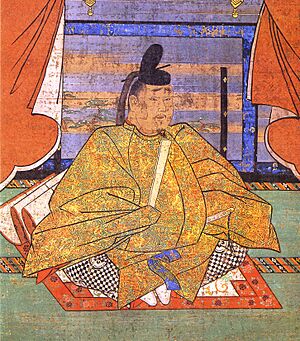Emperor Murakami facts for kids
Quick facts for kids Emperor Murakami村上天皇 |
|||||
|---|---|---|---|---|---|
 |
|||||
| Emperor of Japan | |||||
| Reign | 23 May 946 – 5 July 967 | ||||
| Coronation | 31 May 946 | ||||
| Predecessor | Suzaku | ||||
| Successor | Reizei | ||||
| Born | 14 July 926 Heian Kyō (Kyōto) |
||||
| Died | 5 July 967 (aged 42) Seiryōden of the Heian Kyō |
||||
| Burial | Murakami no misasagi (村上陵) (Kyōto) | ||||
| Spouse | Fujiwara no Anshi | ||||
| Issue more... |
|||||
|
|||||
| House | Yamato | ||||
| Father | Emperor Daigo | ||||
| Mother | Fujiwara no Onshi | ||||
Emperor Murakami (村上天皇, Murakami-tennō, born 14 July 926 – died 5 July 967) was the 62nd emperor of Japan. He ruled from 946 until his death in 967. He was an important figure in Japanese history, especially during the Heian period.
Becoming Emperor
Before he became emperor, his personal name was Nariakira-shinnō. He was the 14th son of Emperor Daigo. His older brother, Emperor Suzaku, was emperor before him.
In 944, Nariakira-shinnō was chosen to be the next emperor. Two years later, he officially became emperor.
- 16 May 946: Emperor Suzaku stepped down from the throne. His younger brother, Nariakira-shinnō, took his place. This event is called the senso.
- 31 May 946: Emperor Murakami, who was 21 years old, officially became emperor in a ceremony called the sokui.
Important Events During His Reign
When Emperor Murakami first became emperor, his uncle, Fujiwara no Tadahira, was a powerful helper called a Sessho (regent). A regent is someone who helps rule the country when the emperor is too young or unable to rule alone.
After Tadahira died in 949, Emperor Murakami ruled directly. People at the time praised him for this. However, the powerful Fujiwara clan still had a lot of influence over Japan. Two brothers from this clan, Fujiwara no Saneyori and Fujiwara no Morosuke, were very important in running the country.
- 23 October 949: The former Emperor Yōzei passed away.
- 951: Emperor Murakami ordered a special collection of Japanese poems called Gosen Wakashū to be created. This project was done by a group of talented poets known as the Five Men of the Pear Chamber.
- 6 September 952: The former Emperor Suzaku passed away.
- 16 October 960: The Imperial palace in Heian-kyō (which is now Kyoto) burned down. This was the first time the palace had been destroyed by fire since the capital moved there in 794.
Emperor Murakami was also known for his love of culture and arts. He was a very skilled musician who played the flute and the koto (a Japanese harp).
- 5 July 967: Emperor Murakami passed away at the age of 42.
His burial place is known as Murakami no misasagi in Kyoto. It is a special Shinto shrine where he is honored. The Imperial Household Agency, which manages royal affairs, officially calls this place his mausoleum.
Eras of His Reign
The years of Emperor Murakami's rule are known by several different era names or nengō:
Family
Emperor Murakami had many consorts and children. His main wife was Empress Fujiwara no Anshi (927–964).
Some of his notable children include:
- Imperial Prince Norihira, who later became Emperor Reizei.
- Imperial Prince Morihira, who later became Emperor En'yū.
He also had many other sons and daughters with different consorts.
See also
 In Spanish: Murakami Tennō para niños
In Spanish: Murakami Tennō para niños
- Emperor of Japan
- List of Emperors of Japan
- Imperial cult
- Emperor Go-Murakami
| Regnal titles | ||
|---|---|---|
| Preceded by Emperor Suzaku |
Emperor of Japan: Murakami 946–967 |
Succeeded by Emperor Reizei |

